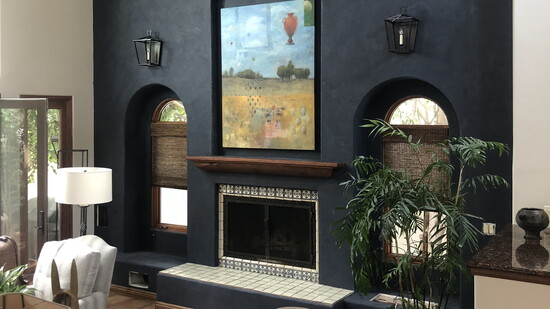Peter Kelley, owner of Manhattan Paint Company, knows his stuff—not just because he's studied the science behind sheen and color tones, but because he’s lived it. His journey began at 18, after he crashed his dad’s car. To pay for the car repairs, his father told him he would be painting a neighbor’s house trim. That’s where Peter learned to paint or so he thought.
A few years later while home from college for the summer, his dad connected him with Mr. Pearson, a semi-retired painting contractor repairing an office building in South Redondo. Mr. Pearson asked Peter if he had painting experience. “Sure,” Peter replied. “I put a drop cloth down, grabbed a bucket and a paint brush, and started painting. I got two strokes and Mr. Pearson said, ‘Stop kid. You’re one of the worst painters I’ve ever seen.’”
It was a humbling start that turned into a life-changing mentorship. Mr. Pearson taught Peter how to hold sandpaper, how to use it, and how to sand surfaces with precision. That “Mr. Miyagi moment,” as Peter calls it, launched a decades-long career built on craftsmanship, color instincts, and a respect for prep. “When I prep it, I’m able to know what it’s going to look like when I put paint on it,” explained Peter. “If you cut corners in prep, sometimes when you put the paint on, you’re going to see that corner that you cut.”
While Manhattan Paint Company handles both residential and commercial projects, about 70% of their business comes from transforming local homes. Peter says the era of cool grays is phasing out. “We're moving back towards softer whites. And I'm seeing a lot of earth tones like greens.” Accent walls remain a popular way to anchor a space—whether behind a bed, across from French doors, or as a pop of color in a neutral room. “Accent walls are designed to pull the space visually to make it look longer or bigger,” explained Peter.
Beyond color, the paint finish is where style meets science. Flat paint hides imperfections like a dream but absorbs dirt. Eggshell, matte, and satin finishes are smoother and more durable. Peter compares paint finish to car upholstery. “You have leather seats in your car and you spill some water on it. It just wipes off,” said Peter. “If you have cloth seats in your car and you spill some water, your cloth is wet because the cloth is porous. That's the difference between flat versus eggshell or semi gloss.”
In moisture-prone areas like kitchens and bathrooms, eggshell is often the sweet spot—offering enough sheen to handle humidity without the glossy shine of semi-gloss. When choosing paint, consider both trends and function. If you have young kids, dogs, or just tend to touch the walls a lot, a flat finish isn’t ideal, especially in highly trafficked areas like stairwells and hallways. A finish with some sheen is easy to wipe away those little hand- and pawprints.
He also warns about the "one coat" marketing myth. Paints that promise one-coat coverage often disappoint—especially going from dark to light. Peter always applies two coats to guarantee even, lasting coverage.
Coverage is only part of the equation. Choosing the right color for the style of home is just as critical. Peter appreciates the diversity of Redondo’s neighborhoods—from two-on-a-lots in North Redondo to Spanish, Craftsman, and Mid-Century gems in South Redondo—and says it’s important to consider a home’s architecture when selecting paint colors, not just follow trends. He recalled a mid-century project that struck the perfect balance. “Because the house got a new color paint, it looks modernized, but at the same time it held the integrity of a mid-century ranch,” he said. “We weren’t trying to make a mid-century look like a 21st-century modern. I really like working on houses when we’re able to do things like that.”
From thoughtful prep to finish selection and color matching, painting—done right—is an art, a science, and a lasting investment in your home. It’s not just about choosing the right shade or following the latest trend; it’s about understanding how surfaces behave, how lighting shifts color throughout the day, and how quality materials and proper prep protect your home for years to come. Whether you're refreshing a sun-faded exterior, modernizing a living room, or simply making a space feel more like home, the key is doing it right—whether that means hiring the right company or taking your time as a DIYer. Style may start with color, but lasting results come from experience, attention to detail, and a deep respect for the process.
SIDE BAR COPY:
Prep Like a Pro: Do’s and Don’ts
Peter Kelley’s painting tips for a flawless, long-lasting finish.
Do:
- Use primer on raw wood or fresh drywall to seal the surface and help paint adhere evenly.
- Sand glossy surfaces so new paint sticks.
- Test multiple swatches in different spots and natural lighting before committing to a color.
- Choose finishes based on lifestyle—how you live matters more than how it looks.
Don’t:
- Expect one coat to cover everything, especially when painting over dark colors.
- Use flat paint in moisture-prone spaces like kitchens and bathrooms—it won’t hold up.
- Skip the sanding step—this prep is what separates pros from amateurs.
- Put semi-gloss on sun-drenched, vaulted walls (avoid a blinding glare).
